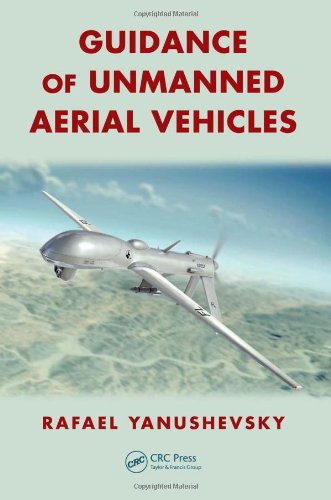

Most ebook files are in PDF format, so you can easily read them using various software such as Foxit Reader or directly on the Google Chrome browser.
Some ebook files are released by publishers in other formats such as .awz, .mobi, .epub, .fb2, etc. You may need to install specific software to read these formats on mobile/PC, such as Calibre.
Please read the tutorial at this link: https://ebookbell.com/faq
We offer FREE conversion to the popular formats you request; however, this may take some time. Therefore, right after payment, please email us, and we will try to provide the service as quickly as possible.
For some exceptional file formats or broken links (if any), please refrain from opening any disputes. Instead, email us first, and we will try to assist within a maximum of 6 hours.
EbookBell Team

4.0
46 reviews
ISBN 10: 143985095X
ISBN 13: 9781439850954
Author: Rafael Yanushevsky
Written by an expert with more than 30 years of experience, Guidance of Unmanned Aerial Vehicles contains new analytical results, taken from the author’s research, which can be used for analysis and design of unmanned aerial vehicles guidance and control systems. This book progresses from a clear elucidation of guidance laws and unmanned aerial vehicle dynamics to the modeling of their guidance and control systems. Special attention is paid to guidance of autonomous UAVs, which differs from traditional missile guidance. The author explains UAV applications, contrasting them to a missile’s limited ability (or inability) to control axial acceleration. The discussion of guidance laws for UAVs presents a generalization of missile guidance laws developed by the author. The computational algorithms behind these laws are tested in three applications—for the surveillance problem, the refueling problem, and for the motion control of a swarm of UAVs. The procedure of choosing and testing the guidance laws is also considered in an example of future generation of airborne interceptors launched from UAVs. The author provides an innovative presentation of the theoretical aspects of unmanned aerial vehicles’ guidance that cannot be found in any other book. It presents new ideas that, once crystallized, can be implemented in the new generation of unmanned aerial systems.
1 Basics of Guidance
1.1 Introduction
1.2 Guidance Process
1.3 Missile Guidance
1.4 Guidance of Cruise Missiles and Uavs
1.5 Representation of Motion
1.6 Line-of-Sight
1.7 Longitudinal and Lateral Motions
References
2 Control of Lateral Motion
2.1 Introduction
2.2 Parallel Navigation
2.3 Proportional Navigation. Planar Engagement
2.4 Proportional Navigation. Three-Dimensional Engagement
2.5 Augmented Proportional Navigation
2.6 Proportional Navigation As A Control Problem
2.7 Augmented Proportional Navigation As A Control Problem
2.8 When Is the PN Law Optimal?
References
3 Control of Longitudinal and Lateral Motions
3.1 Introduction
3.2 Guidance Correction Controls
3.3 Lyapunov Approach To Control Law Design
3.4 Bellman-Lyapunov Approach. Optimal Guidance Parameters
3.4.1 Optimal Guidance for Nonmaneuvering Targets
3.4.2 Optimal Augmented Guidance Laws
3.5 Modified Linear Planar Model of Engagement
3.6 General Planar Case
3.7 Three-Dimensional Engagement Model
3.8 Generalized Guidance Laws
3.9 Modified Generalized Guidance Laws
3.10 Examples
References
4 Analysis of Proportional Navigation Guided Systems in the Time Domain
4.1 Introduction
4.2 Inertialess Pn Guidance System
4.3 Method of Adjoints
References
5 Analysis of Proportional Navigation Guided Systems in the Frequency Domain
5.1 Introduction
5.2 Adjoint Method. Generalized Model
5.3 Frequency Domain Analysis
5.4 Steady-State Miss Analysis
5.5 Weave Maneuver Analysis
5.6 Example
5.7 Frequency Analysis and Miss Step Response
5.8 Bounded Input—Bounded Output Stability
5.9 Frequency Response of the Generalized Guidance Model
References
6 Design of Guidance Laws Implementing Parallel Navigation. Frequency-Domain Approach
6.1 Introduction
6.2 Neoclassical Missile Guidance
6.3 Pseudoclassical Missile Guidance
6.4 Example Systems
6.4.1 Planar Model of Engagement
6.4.2 Multidimensional Model of Engagement
References
7 Guidance Law Performance Analysis under Stochastic Inputs
7.1 Introduction
7.2 Brief Discussion of Stochastic Processes
7.3 Random Target Maneuvers
7.4 Analysis of Influence of Noises on Miss Distance
7.5 Effect of Random Target Maneuvers on Miss Distance
7.6 Computational Aspects
7.7 Examples
7.8 Filtering
References
8 Guidance of UAVs
8.1 Introduction
8.2 Basic Guidance Laws and Vision-Based Navigation
8.3 Generalized Guidance Laws for Uavs
8.3.1 Waypoint Guidance Problem
8.3.2 Rendezvous Problem
8.3.3 Conditional Rendezvous Problem
8.4 Guidance of A Swarm of Uavs
8.5 Obstacle Avoidance Algorithms
References
9 Testing Guidance Laws Performance
9.1 Introduction
9.2 Forces Acting on Unmanned Aerial Vehicles
9.3 Reference Systems and Transformations
9.4 Unmanned Aerial Vehicles Dynamics
9.5 Autopilot and Actuator Models
9.6 Seeker Model
9.7 Filtering and Estimation
9.8 Kappa Guidance
9.9 Lambert Guidance
9.10 Simulation Models of Unmanned Aerial Vehicles
9.10.1 6-DOF Simulation Models
9.10.2 3-DOF Simulation Models
References
10 Integrated Design
10.1 Introduction
10.2 Integrated Guidance and Control Model
10.3 Synthesis of Control Laws
10.3.1 Minimization of Standard Functionals
10.3.2 Minimization of Special Functionals
10.4 Integration and Decomposition
References
11 Guidance Laws for Boost-Phase Interceptors Launched from UAVs
11.1 Introduction
11.2 Kill Vehicles for Boost-Phase Defense
11.3 Development of the Missile Model and Selection of Guidance Law Parameters
11.4 Endgame Requirements and the Comparative Analysis of Efficiency of Guidance Laws
11.4.1 Planar Model
11.4.2 3-DOF Model. Nominal Trajectory
11.4.3 3-DOF Model. Step and Weaving Target Maneuvers
11.5 Advanced Guidance Laws Applied To Boost Stage
11.5.1 Interceptor ′s Model
11.5.2 Simulation Results. Nonmaneuvering Target
11.5.3 Simulation Results. Influence of Shaping Term
11.6 Interceptor′S Performance with Axial Control
11.6.1 Axial Control of Kill Vehicle
11.6.2 Axial Control of Interceptor
11.7 Comparative Analysis with Lambert Guidance
guidance navigation and control of fixed wing unmanned aerial vehicles
unmanned aerial vehicle uses
examples of unmanned aerial vehicles
guidance for the domestic use of unmanned aircraft systems
unmanned aerial vehicle (uav) definition
use of unmanned aerial vehicles
unmanned aerial vehicles (uavs)
Tags: Rafael Yanushevsky, Unmanned, Aerial